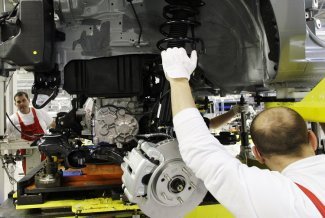Employees assemble a battery pack for electric cars at the assembly line at the PSA Peugeot Citroen plant in Trnava, Slovakia on 16 July 2020.
In order to meet the climate commitments agreed in Paris in 2015 and the terms of the European Green Deal, which aims to make Europe the first climate-neutral continent by 2050, the European Union has pledged to reduce emissions by 55 per cent by 2030. To meet this target, the EU has created a Fit for 55 package, which – amongst other measures – effectively bans the sale of petrol and diesel cars by 2035.
This represents both an uphill challenge and an opportunity in the central European country of Slovakia, where electric vehicles (EVs) accounted for just 1.2 per cent of new car sales in 2020, compared to six per cent of new car sales across Europe.
“Electric vehicles are not affordable for ordinary Slovakians,” says Monika Benedeková, the vice-president of the Slovakian metalworkers’ union OZ KOVO. “Slovakians buy old cars from other European countries, because the average monthly wage is approximately €1,200 and many people do not even make that.” Most EVs cost somewhere between €30,000 and €50,000. A lack of infrastructure, especially battery-charging stations, is a further barrier to EV ownership. In addition, banning Europe-wide petrol and diesel car sales also threatens jobs, as Slovakia currently produces the largest number of automotives per capita anywhere in the world.
“The car industry has created 177,000 direct and 270,000 supply chain jobs,” says Benedeková, and it accounts for 13 per cent of Slovakia’s GDP. There is no doubt that the electric vehicle market is set to grow substantially; according to some forecasts, the size of the European market is projected to grow at a compound annual growth rate of 29.6 per cent between 2021 and 2028. But there are challenges ahead.
“One issue for the automotive sector is that the production of electric vehicles is less labour intensive than the production of combustion engines. Therefore, in the medium to long term, a certain number of jobs in the automotive sector are under threat in the European Union,” explains Félix Mailleux, an advisor on climate, energy and industrial policies at the European Trade Union Confederation (ETUC).
An estimated 13.8 million Europeans work in the automotive sector, including supply chain jobs. EVs can have ten times fewer parts, which means fewer jobs. Petrol and diesel cars drove economic transformation in Slovakia over the last 30 years; in 1993, the country made less than 3,000 vehicles.
This figure rose to one million by 2015 and has been increasing ever since, apart from a dip due to the Covid pandemic. Most vehicles in Slovakia are made by foreign multinationals such as Volkswagen, the PSA Group (Peugeot, Citroën, DS, etc.), Kia and Jaguar Land Rover.
Slovakia-produced EVs include Volkswagen’s e-UP, PSA’s e-208 and Jaguar’s I-PACE. Comparing making EVs with combustion engine cars, Benedeková explains that production happens in the same plant: “It is one collective agreement and the working conditions are exactly the same.”
Yet most Slovakia-produced cars have combustion engines, with approximately eight per cent of production devoted to electric vehicles. All four Visegrád countries – Slovakia, Czechia, Hungary and Poland – are major car producers relying on foreign-owned multinationals. “Not only are they dependent on foreign investment, but the decision-making is elsewhere. This means that in terms of anticipating what will come, how can they prepare the workforce?” asks Isabelle Barthès, deputy general secretary of the IndustriAll Europe trade union.
Benedeková explains that in Slovakia, the origin of multinational companies impacts labour relations: “We have a very good experience with the German companies, as they have a strong tradition of social dialogue and replicate their social environment in Slovakia. But we have had another experience with Asian companies. It was really hard to start the collective bargaining, start the social dialogue or even create a trade union. But, for example, with Kia we succeeded.” This success, fomented by strike action, meant that Kia increased pay at its Slovakian plant by 8.8 per cent in 2017.
Parallel problems in Czechia
Neighbouring Czechia also relies on a large automotive sector, which faces similar challenges. Until recently, the sector accounted for 170,000 jobs, although mainly in assembly, as Jaroslav Souček, president of the Czech metalworkers’ federation OS KOVO, points out.
In total, the automotive sector compromises a tenth of Czechia’s GDP and revolves around three foreign-owned firms: Hyundai, Toyota and Volkswagen, which bought Škoda, the then-Czechoslovakia’s emblematic national car company in 1990. Currently one-tenth of Czech-built cars are electric, mainly by Škoda and Hyundai – a figure close to the EU average.
With the sector heavily reliant on combustion engine cars, Souček fears that the EU’s timetabled transition to electric vehicles is too ambitious, as decisions will be made by foreign-owned companies: “We are scared the jobs will simply disappear, and we have no idea how many quality jobs will be created.”
In Czechia’s car companies, the last sectoral collective agreement was concluded in 1993 at Škoda. Yet, like in neighbouring Slovakia, Czech car workers have successfully used strike action as leverage for better pay and conditions.
Slovakia and Czechia (which were united under a single, Soviet satellite state until they slowly split into two republics between 1989 and 1993) are both top per capita car producers today, yet their histories differ. The year 1991 – two years before Czechoslovakia’s dissolution – was an important year for Slovakia, as mass car production began with Volkswagen. Czechia’s car manufacturing industry goes back further. It was the most industrialised part of the Austro-Hungarian empire, and its late-nineteenth century companies included Tatra, which used to make luxury vehicles and now produces trucks, and bicycle and motorbike makers Laurin & Klement, which became Škoda.
Yet from different starting points, both countries face similar dilemmas with automotive electrification. “The strategic value chains of electric vehicles are currently not located in the EU. They are indeed often located in Asia for semi-conductors and batteries, which are key components in EVs. Besides, many of the electric cars sold in the EU at the moment are produced in the US. This is a risk for the European workers because their jobs could move outside of the EU,” explains Mailleux.
In Slovakia, Benedeková says that already in combustion engine supply chains, wages are a lot less than in direct automotive employment. However, she also notes positive developments, such as increased investment by companies in research and development as well as professional retraining.
Just transition: from words to action
One means to create quality EV supply chain jobs is producing lithium batteries. “At the moment we only have one [Slovakian] company called Inobat,” Benedeková says. “It is an innovative company producing batteries for EVs. They have one small plant in Voderady, with plans to establish a bigger one in Košice, which should employ 3,000 people.”
But elsewhere, decarbonised employment does not necessarily translate into high-quality jobs. “In Hungary, foreign investors have already invested into several battery plants. But the feedback we have from colleagues is that although the industry conveys an image of high-end technology, the jobs are really bad,” IndustriALL’s Barthès explains. “The question of the job quality is essential.”
Mailleux points out a similar issue with Tesla, a US company with a strong anti-union track record, now planning to develop a plant in Berlin. “Investments for new production plants in Europe are welcome of course, but they need to be accompanied by strong social commitments. If the company persists with the same union-busting culture, this could weaken working conditions in the sector, in terms of wages, health and safety, and collective bargaining rights,” he says.
Another major shift in car production involves digitalisation. “Many car producers invest in robotisation,” Benedeková says.
“Volkswagen has a big hall without anyone there, because the people are hidden somewhere else programming the robots. So digitalisation reduces the number of jobs, even if their quality gets higher.”
Mailleux says the ETUC is satisfied with Fit for 55’s ambition in terms of emissions reductions. However, one problem is that the stated green aims of the EU package are not matched with elements to ensure social justice. “For instance, we want member states to create detailed employment impact assessments of the different components,” says Mailleux. He is also calling for just transition plans co-created by public authorities and social partners through social dialogue, and for any new funding to have social conditionalities so that companies can ensure quality jobs.
Barthès echoes this point and explains how IndustriALL and other European trade unions are assisting colleagues, who do not have a strong tradition of social dialogue, in Central and Eastern Europe. “We are trying to enshrine into [both EU and national] legislation what just transition really means, and one of the key elements is social dialogue.”
These transnational perspectives are reflected on by both the Slovakian and Czech unions.
Benedeková says that when she saw the Slovakian government’s draft proposal for just transition in the automotive sector, which is not yet published, she was not impressed: “Trade unions were not even involved in negotiating it. The social dialogue is very limited.” She compares this to Slovakia’s just transition plan for phasing out coal, developed since 2019, which despite falling short in its attempts to create new jobs, at least attempts to do so via dialogue with unions.
Czechia in December 2021 saw a change in government. “The new government is much more orientated towards EU policy, including just transition. But how it will look like in practice is difficult to say,” says Souček, adding that the new government is currently focused on navigating the impact of Covid and its response to the war in Ukraine.
The impact of the Russian invasion of Ukraine
Trade unions across Europe have condemned Russia’s invasion of Ukraine. At this stage the fallout of the war is difficult to define, but the interviewees fear the war spreading and their immediate focus is on supporting colleagues and refugees from Ukraine.
The war could accelerate a phase-out of fossil fuels, as European governments seek to end Russian oil imports. Reciprocally, unless energy efficiency and renewables fill this gap, the shortfall in energy supply from Russia is motivating calls to slow down the just transition process, particularly the coal phase-out. It also motivates arms spending, which could divert money from just transition, the interviewees reflect.
In immediate terms, sanctions mean that many foreign industries have left Russia. Russia and Ukraine are also both large suppliers of aluminium, nickel, palladium and other vital materials for both combustion engines and EVs. Due to supply chain shortages, Škoda in Czechia is already limiting production, says Souček.
In Slovakia, Benedeková suggests the war will only escalate a cost of living crisis, increase people’s debts and make people postpone moving to EVs. Both trade union representatives connect the popularity of EVs to their affordability and their job creation potential; both of which are impacted by the war.
One way to move away from the reliance on combustion engine vehicles yet generate good jobs would be to develop high-quality decarbonised public transport. Czechia is already a bus and train mass-producer.
A 2021 report from the Rosa Luxemburg Foundation, The Need for Transformation – Current Challenges for the International Automotive Sector, focuses on this, arguing for job creation both in production and in the running of services. Against the deepening cost of a global cost of living crisis, scarcity of resources and a need to end imports from Russia, this could help overcome the challenges facing the automotive sector.
Mailleux agrees. “There is a need to enlarge the discussion with policymakers and manufacturers to accelerate the uptake of public transport, and not only electric cars. In the long term, there are challenges with simply replacing the combustion engine within individual EVs – simply the material availability or even the environmental impact.”
Benedeková points out that EVs will not resolve the massive congestion problems suffered by cities such as the Slovakian capital Bratislava. Union representatives from both countries say that people highly rate public transport, which is increasingly electrified or decarbonised by hydrogen. According to Souček, 90 per cent of people in Prague use public transport regularly. Slovakia has increased rail usage, offering free travel to students and over-65s.
Barthès agrees that producing the means of public transport could compensate the removal of combustion engines, but there is an obstacle with the timing: “You have a short time to phase out the combustion engine, whereas to phase in the production of public transport takes time and investment. But we need to phase in new jobs before we phase out the old ones.”












